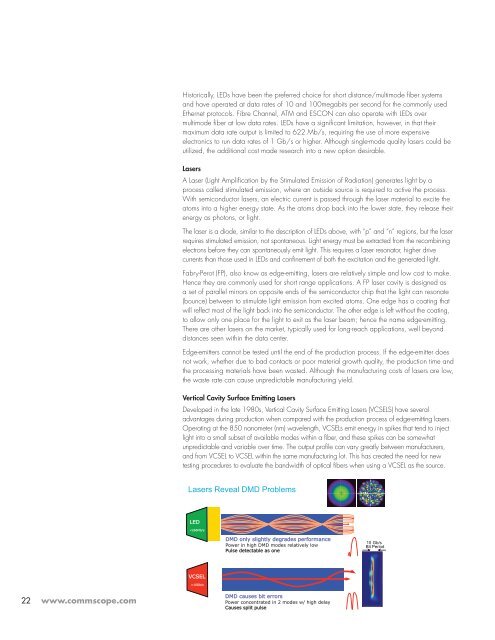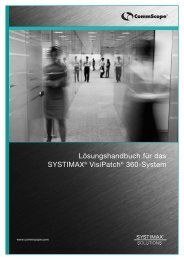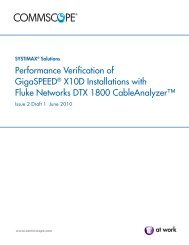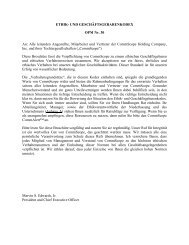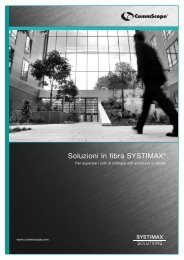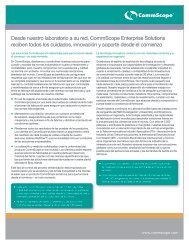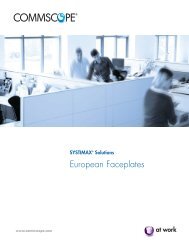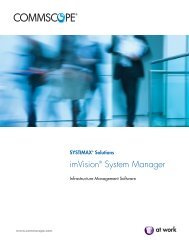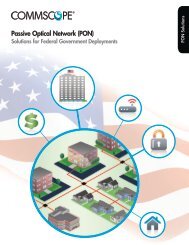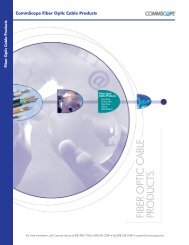CommScope® Enterprise Data Center Design Guide - Public ...
CommScope® Enterprise Data Center Design Guide - Public ...
CommScope® Enterprise Data Center Design Guide - Public ...
Create successful ePaper yourself
Turn your PDF publications into a flip-book with our unique Google optimized e-Paper software.
22<br />
www.commscope.com<br />
Historically, LEDs have been the preferred choice for short distance/multimode fiber systems<br />
and have operated at data rates of 10 and 100megabits per second for the commonly used<br />
Ethernet protocols. Fibre Channel, ATM and ESCON can also operate with LEDs over<br />
multimode fiber at low data rates. LEDs have a significant limitation, however, in that their<br />
maximum data rate output is limited to 622 Mb/s, requiring the use of more expensive<br />
electronics to run data rates of 1 Gb/s or higher. Although single-mode quality lasers could be<br />
utilized, the additional cost made research into a new option desirable.<br />
Lasers<br />
A Laser (Light Amplification by the Stimulated Emission of Radiation) generates light by a<br />
process called stimulated emission, where an outside source is required to active the process.<br />
With semiconductor lasers, an electric current is passed through the laser material to excite the<br />
atoms into a higher energy state. As the atoms drop back into the lower state, they release their<br />
energy as photons, or light.<br />
The laser is a diode, similar to the description of LEDs above, with “p” and “n” regions, but the laser<br />
requires stimulated emission, not spontaneous. Light energy must be extracted from the recombining<br />
electrons before they can spontaneously emit light. This requires a laser resonator, higher drive<br />
currents than those used in LEDs and confinement of both the excitation and the generated light.<br />
Fabry-Perot (FP), also know as edge-emitting, lasers are relatively simple and low cost to make.<br />
Hence they are commonly used for short range applications. A FP laser cavity is designed as<br />
a set of parallel mirrors on opposite ends of the semiconductor chip that the light can resonate<br />
(bounce) between to stimulate light emission from excited atoms. One edge has a coating that<br />
will reflect most of the light back into the semiconductor. The other edge is left without the coating,<br />
to allow only one place for the light to exit as the laser beam; hence the name edge-emitting.<br />
There are other lasers on the market, typically used for long-reach applications, well beyond<br />
distances seen within the data center.<br />
Edge-emitters cannot be tested until the end of the production process. If the edge-emitter does<br />
not work, whether due to bad contacts or poor material growth quality, the production time and<br />
the processing materials have been wasted. Although the manufacturing costs of lasers are low,<br />
the waste rate can cause unpredictable manufacturing yield.<br />
Vertical Cavity Surface Emitting Lasers<br />
Developed in the late 1980s, Vertical Cavity Surface Emitting Lasers (VCSELS) have several<br />
advantages during production when compared with the production process of edge-emitting lasers.<br />
Operating at the 850 nanometer (nm) wavelength, VCSELs emit energy in spikes that tend to inject<br />
light into a small subset of available modes within a fiber, and these spikes can be somewhat<br />
unpredictable and variable over time. The output profile can vary greatly between manufacturers,<br />
and from VCSEL to VCSEL within the same manufacturing lot. This has created the need for new<br />
testing procedures to evaluate the bandwidth of optical fibers when using a VCSEL as the source.<br />
Lasers Reveal DMD Problems<br />
LED<br />
10Gb/s<br />
DMD only slightly degrades performance<br />
Power in high DMD modes relatively low<br />
Pulse detectable as one<br />
DMD causes bit errors<br />
Power concentrated in 2 modes w/ high delay<br />
Causes split pulse<br />
10 Gb/s<br />
Bit Period


